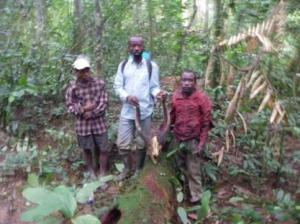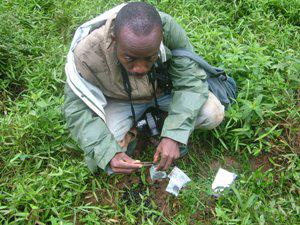Yede
This project aimed at estimating the abundance, distribution and feeding behaviour of Tragelaphus eurycerus in the Dja Reserve, in order to develop a conservation plan.

Skull of a bongo identified in the Dja Reserve.
The Bongo (Tragelaphus eurycerus) is the largest and heaviest forest antelope. Very little data exist on the ecology and distribution of this species in the southern Cameroon rainforest. Habitat disturbance and poaching have caused severe reduction of bongo populations in this area. Thus, few bongo observations had been reported over the last few years in the southern Cameroon rainforest. Baseline data on the species’ abundance, movements, habitat choice and distribution are urgently needed in other to prevent its disappearance altogether.
Footprints of bongo identified in the Dja Reserve by the trackers.
The distribution of the lowland Bongo is limited to Africa and confined to a few central and western countries. Therefore, the habitat requirements of this species could be considered exigent, explaining their constrained geographical distribution. This project is expected to elucidate baseline data on the bongo’s number and distribution, while revealing fundamental ecological information about its habitat requirements in the study site.
Faecal pellets of bongo identified in the Dja Reserve by the trackers.
Three main activities will be conducted to achieve these objectives:

1- Sampling of bongo individuals will be conducted monthly (10 days per month). Sampling will be done with trackers, maintaining a general heading, but following paths of least resistance. Samplers would spread out where possible to broaden the search and maximize chances of finding signs. We will make sure our searches are geographically representative, or representative of the different habitat types. Surveys will be placed to be as well spread within the different habitats as possible and track will be recorded with GPS.
2- Local communities within/around the reserve will be given a questionnaire to evaluate their knowledge about bongo, the hunting pressure on this species and the trends (increasing/decreasing) of the population.
3- Efforts will be made to promote conservation education and awareness, specifically focusing on the need to reduce hunting/poaching at all levels. Outreach to decision makers, general public, schools and local communities (especially hunters) will be achieved through a series of seminars and conferences.
The data obtained will be immediately relevant to local conservation organizations’ programs and allow decision makers to increase protective measures where necessary and promote the protection of this critically endangered species.